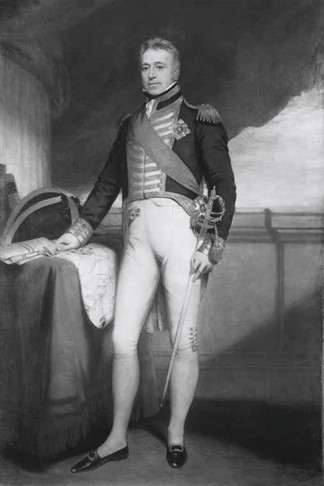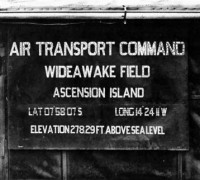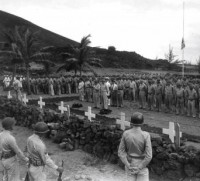ASCENSION ISLAND AND THE SECOND WORLD WAR - ASCENSION ISLAND IN THE WAR
2)BRITISH SETTLEMENT 1815 - 1939
BY DAVID FONTAINE MITCHELL
On 22 October 1815, the British rear-admiral George Cockburn officially annexed Ascension following his escort of Napoleon Bonaparte to the “nearby” island of St. Helena, located roughly 750 miles to the southeast. Cockburn wanted to ensure that Ascension was not to be used as a staging base by the French or other adversaries who might have been planning Napoleon’s escape. He therefore instructed his men to establish a garrison and a lookout post to survey each vessel that approached the island in order to avoid another “Return from Elba.” Tristan da Cunha, located to the south of St. Helena, was annexed in 1816 to serve a similar purpose. During the first year of inhabitation, the Royal Navy instituted a system of gutters and pipes to transport fresh water, began the construction of a road, and started work on the island’s first pier.
The island’s first communication system—semaphores placed atop mountain summits —was also established at this time. By the 1830s, merely one decade following the death of Napoleon in 1821, Ascension had become a sanatorium for men of the West Africa Squadron who fell ill with various diseases during anti-slaving patrols. Britain ultimately decided to retain their presence on Ascension at this time due to the island’s close proximity to West Africa and its strategic placement on the south-east trade-winds. In this era before the construction of the Panama and Suez canals, the island was also utilized as a base for British ships sailing long distances around the globe. The Royal Marines took command of the island in 1823 with the arrival of Lt. Colonel Edward Nicolls, who oversaw the construction of numerous public works projects during his five-year stint. (Command of the island was officially transferred back to the Navy in 1844, only to return to the Marines again in 1905.) Nicolls continued the practice of housing sick sailors on the island so that they could recuperate. In a letter to the governor of Sierra Leone, the commandant stated the following:
It is with sincere regret that I have heard of the death of some of your most valued officers, and think it is my duty to inform you that if you require the bracing cool air of mountains, I have a humble but clean (and to me) a very comfortable and healthy abode much at your service. We have plenty of good vegetables, mutton, beef, poultry, fish, tea, coffee, milk and eggs to all which, I will give an old soldier’s hearty welcome to any of your officers or friends that you may entrust to my care.

George Cockburn
Nicolls was replaced by Captain William Bate in 1828, who served for 10 years on Ascension until his abrupt death in 1838 after contracting an illness brought in by a visiting ship. During Bate’s tenure, he oversaw the development of an intricate water system, the island’s first official barracks, and a hospital that is still used to this day. The steadily growing garrison-town was officially coined Georgetown by the captain on 3 April 1829 in honor of King George IV. By 1830, there were roughly 200 people living on Ascension, including 86 Africans, and ships were calling at the island’s port with regularity.
Bate wasn’t the only commandant to fall victim to the various illnesses brought to the island. His official successor, Captain Roger Tinklar, passed away in 1839 after only one year on Ascension, and Tinklar’s replacement, Captain Henry Bennett, survived there a mere seven months. By this time there were two hospitals on the island, and one was reserved specifically for those with severe fevers. Ships with sick men had been quarantined from the populace in a section of the island known as Comfortless Cove since 1823, after a visit by the infected HMS Bann resulted in the deaths of several men stationed at the garrison.
Charles Darwin visited the island from 19 - 23 July 1836 during his global expedition aboard the Beagle. He noted:
The settlement is near the beach; it consists of several houses and barracks placed irregularly, but well built of white freestone. The only inhabitants are marines, and some negroes liberated from slave-ships, who are paid and victualled by government. There is not a private person on the island. Many of the marines appeared well contented with their situation; they think it better to serve their one-andtwenty years on shore, let it be what it may, than in a ship; in this choice, if I were a marine, I should most heartily agree.
He described the terrain of the island as being “entirely without trees, in which, and in every other respect, it is very far inferior to St. Helena…I saw the island, not smiling with beauty, but staring with naked hideousness.” Darwin was overlooking Ascension’s barren landscape, one void of vegetation with scattered basaltic lava flows and numerous reddishbrown craters. A later observer would describe the territory as being almost lunar in nature. Darwin’s assistant, Syms Covington, observed the British outpost in his journal as follows:
The soldiers HERE appear well satisfied, although there is scarcely anything green on the whole island; as for their work they get their food, and of course their full pay as usual. The different departments are all built of sandstone, ARE uncommonly clean and commodious, and indeed every thing appears as if done for the common comfort of all.
Although numerous guns had been positioned at various locations throughout the island since the start of the British occupation, these were rarely maintained and highly deficient. Had an adversary truly wanted to seize Ascension from the British during the 1800s, they most likely would have succeeded with relative ease. However, the garrison was blessed by the fact that no other nation at the time perceived the small landmass as having any considerable value. This perception was shared by several within the British military, and by the mid-1860s serious consideration was given to abandoning the island. Many believed Ascension to be no longer of any value following Napoleon’s death and the diminishment of the slave trade.
The opening of the Suez Canal in November 1869 also dealt a substantial blow to the island’s vitality and, coupled with a recent decision to move the West Africa Squadron’s base from Ascension to Cape Town, its future appeared bleak. It was therefore suggested that the Royal Navy move its base to St. Helena, where they could conduct their African operations in what was believed to be a better-suited environment. A four-man committee was subsequently sent to Ascension in the late 1860s to assess the viability of the location; however, they unanimously decided to retain the island. This decision was reached, in part, due to St. Helena’s refusal to house sick sailors infected with fever, as the island was afraid of diseases spreading among the general populace. Although Ascension was retained, the number of servicemen on the island was cut by roughly two thirds at the behest of the Admiralty. Talk of abandoning or selling Ascension surfaced with regularity through the remainder of the 19th century, including an unsuccessful proposal in the early 1890s that would have traded the island for the German colony of Damaraland (now Namibia).
Activity on Ascension was relatively quiet until the Eastern Telegraph Company (ETC) arrived in late 1899 with plans of installing an underwater cable network linking Britain to Cape Town via various island nodes. Britain was to be connected to Ascension through the Cape Verde islands, and from there to St. Helena and on to Cape Town, so as to establish a round-about system linking the UK and South Africa. ETC was responsible for the innovation of the first worldwide cable communications network— the “Victorian Internet”—which by 1900 accounted for roughly 100,000 miles of submarine cables. The island was to become a relay station and, on 15 December 1899, the first cable was established between Ascension and St. Helena. The network linking from St. Helena to Cape Town was established in early 1900, followed by another cable to Freetown in 1901.
By early 1908 the station was relaying several thousand messages per month. 1910 witnessed a new cable linking Ascension and Buenos Aires, resulting in an ever-expanding telegraphic network base. Ascension wasn’t the only island that the British were utilizing as a cable relay station at the time; Tabuaeran (Fanning) Island in the mid-Pacific and Direction Island on Coco-Keeling were serving similar purposes. As Simon Winchester succinctly points out in his book Outposts: Journeys to the Surviving Relics of the British Empire, “The British saw cables as the vital synapses of the Imperial nervous system.” By this time, the Empire had control over roughly one quarter of both the world’s land and population. This remote island previously considered insignificant by many was evolving into a mid-Atlantic communications powerhouse.
Ascension continued to provide a link between Britain and various locations and activity on the island remained relatively unaltered during the First World War. The exception was the year of 1914, when the garrison was under fear of attack. The families of ETC employees stationed on the island had been ordered to take refuge on Green Mountain (the island’s largest peak, at 2,870 feet above sea-level) around the time of the Battle of the Falklands on 8 December. Following the elimination of the German South Atlantic squadron in December 1914 and the arrival of Marine reinforcements to Ascension in January 1915, activity on the island resumed as before. Although the Germans could have dealt a substantial blow by sabotaging the cables in and around the island, an attack never commenced, and Ascension went unscathed for the duration of the conflict.
The Admiralty understood the vital significance of the telegraph station, however, and ordered daily reports from the island to confirm that the location had not come under siege. A wireless station was ordered to be constructed in 1915, and was thereafter manned and operated daily during the war, relaying messages from ships in the South Atlantic to the UK and South Africa. On 20 October 1922, roughly four years after the end of the war, the military withdrew from Ascension, leaving possession to the ETC, although the UK retained official control. Most of the military equipment established on the island during the war was either sold or demolished at this time. Several soldiers decided to stay on Ascension following the transfer and were subsequently hired by the cable company as civilian employees.
Upon the ETC’s assumption of the management of island activity on 27 October 1922, Ascension officially became a colonial dependency of St. Helena. For the 107 years up until this point, the island had been uniquely recognized by the British as a “Sloop of War”—the HMS Ascension—to be operated at the discretion of the Admiralty. The commandant of the island was, in essence, the ship’s captain and was therefore responsible for both administrative oversight and discretionary legal justice. Every child born on the island from 1815 to 1922 was officially recognized as having been born at sea. From 1922 onward, however, Ascension became an official territory of the UK, by way of becoming a dependency of a dependency.
It was a rarity for a commercial enterprise to take command of a colony at the time. Stephen A. Royle puts it best: “Ascension was administered by a private sector company, subject to some oversight from another colony, which itself was subject to the UK.” Similar to the military commandants that previously ran the island, the superintendent of the civilian company was responsible for both the administration of daily activities and the law. Relatively little contact was made between Ascension and St. Helena during this period, granting the superintendent almost complete control over the island’s affairs. Although the island was now subjected to civil law for the first time, its unique legal structure deemed that the resident magistrate was also the employer. With no union to represent the workforce at the time, seeking legal action against the employer would have been a difficult task indeed. What’s more, when the St. Helena Colony Development Company was awarded a contract to work on Ascension, they fell under the legal structure administered by the ETC. This meant that one private-sector organization had legal jurisdiction and control over another operating outside of its employ.
The bulk of the 168-person workforce in 1934 consisted of St. Helenians who had been transported to the island from the south-east, while the British predominantly assumed managerial and administrative positions. The employees of the ETC greatly enjoyed their life on the island, and this period witnessed the expansion of numerous recreational facilities, including a cinema club, tennis and badminton courts, an area to play cricket, and greens for golf. The golf course that developed was later recognized by the Guinness Book of Records as the worst in the world, and rightfully so. The lava-barren course, which remains open to this day, is devoid of much grass and is surrounded by rocks and vast wasteland. Recreational activity was important to members of the company, as only one ship arrived annually with visitors and mail.
In 1929 the ETC merged with its associated companies to become Imperial and International Communications Ltd., which changed its name in 1934 to Cable & Wireless Ltd. (C&W). Thousands of messages wired across the Atlantic traveled through Ascension’s cable station each day while the employees enjoyed a secluded, relaxed environment up until the outbreak of war in 1939.
War broke out in Europe in September 1939, and Ascension’s introduction to the latest conflict came just months later when, on 24 December, the island was approached by an unidentified submarine. The alarm sounded to warn the company of a possible attack; however, the approaching vessel turned out to be the HMS Severn stopping in hopes of gathering fresh fruits and vegetables. The Severn was returning to Freetown after an unsuccessful mission to locate the German oil tanker and supply vessel Altmark, which was in the South Atlantic in support of the notorious pocket battleship Admiral Graf Spee at the time. The battleship had had a significant impact as a commerce raider in 1939, sinking nine Allied merchant ships in the Atlantic and causing considerable damage to Allied logistical operations. In recognition of the need to provide adequate security on the island, the Ascension Volunteer Defense Force (AVDF) was established in April 1940. Stephen Cardwell, C&W’s general manager at the time, was put in command of the small 27-person force, assisted by a group of NCOs and an officer of the Royal Artillery recently arrived from St. Helena.
Cont.



